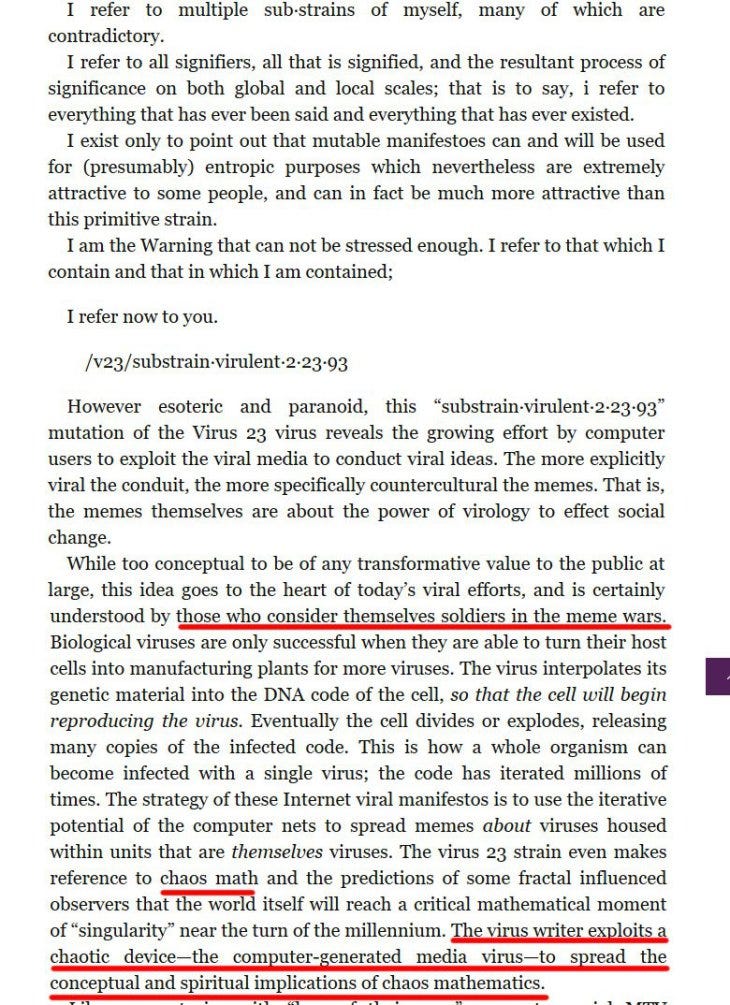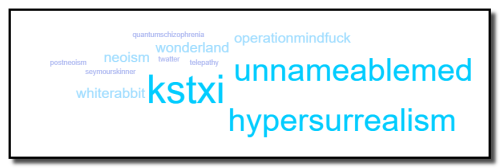
:::
“Media
culture enthusiasts like “Bill Me Tuesday,” a hacker from Santa Cruz,
want computer users to think of viruses more positively. Using a healing
medical model, Tuesday explains: “Viruses can act like a logic
analyzer. As the virus goes through the operating system, it stops at
certain checkpoints, doing its rounds in a given amount of time. This
checkpoint will report back what the condition is.… Essentially the
virus will serve as a means of creating a self-repairing system.… The
goal is a self-repairing, crash resistant system, similar to the way our
bodies repair themselves. Biologically we are the product of thousands
of microorganisms cooperating together. We can apply that kind of
thinking in the computer world. We are modifying the concept of a virus
to serve us.”
These
are the same goals and methods the media viralists have. Presenting
culture as a giant, interconnected organism, they hope to foster a
spirit of cooperation. Using viruses to seek out the cracks or
inconsistencies in existing systems, they develop a culture that repairs
itself much in the way a colony of bacteria mutate to avoid extinction
or an ecosystem adjusts itself to achieve homeostasis. This concept has
gone far beyond the metaphorical level.
A
new kind of computer virus has been appearing on the networks that does
not have anything to do with programming language or crashing systems.
These viruses are meant to serve as memetic devices or meme-carriers,
which express themselves in the way they mutate passing from system to
system, node to node. They work like the kids’ game “telephone,” where a
message is passed around and the joy is in discovering how the message
changed from person to person. When the message is a virus, though, its
contents are hoped to evoke a response.
A
college student on the Internet, Andy Hawks, created a meme collection
he called “Futureculture.” In its first incarnation, Futureculture was a
large list of books, tapes, programs, Internet sites, magazines, and
other media references that Hawks felt would be useful to people who
were interested in developing a new viral culture based on some of the
principles of cyberspace. He posted it as a file in several Internet
locations so that others could reference it, make additions, and pass it
further. So much interest developed in Futureculture that it grew into
an open E-mail forum. Hundreds of Internet users sent mail to one
another through an automatic mailing system at Hawks’s Internet site.
Each user received a daily compilation of all the Futureculture list
additions and periodic updates of the whole, mutated file, which had
expanded to several hundred pages of text. Eventually Futureculture,
which began as a virus, released viruses of its own.
(…)
The virus served as publicity for a new meme-zine, Virus 23, which
features interviews with and articles by science fiction, psychedelic,
physics, GenX, mathematics, and computer experts. The zine is designed
to promote viral initiatives. Following the philosophies of William
Burroughs and cult hero Genesis P-Orridge, the editors see language and
culture as a series of competing viruses and believe that an uncensored
forum for sometimes shocking countercultural ideas will strengthen the
ability of new memes to evolve humanity. They use the number 23, made
famous by occultist Aleister Crowley in the early 1900s and, more
currently, P-Orridge because ancient pagan faiths associate it with
change and the Apocalypse. Self-conscious and overtly viral manifestos
take us into an altogether new cultural territory, where the memes of
ancient shamanism are spliced together with those of futuristic
cyber-technologies. This is the frontier of virus construction, and
though it occurs on a highly conceptual plane it often has very palpable
results.”
:::

:::
:::::::::::::::::::::: Virus 23 Index ::::::::::::::::::::::::::
:::
#thegame23 guides:
“Some people say that #thegame23 mod 42.5
is a complicated A.R.G. disguised as a simple interactive art, other
people say that #thegame23 mod 42.5 is a complicated interactive art
disguised as a simple A.R.G.. Some other people say that #thegame23 mod
42.5 is a complicated interactive joke disguised as a simple
pataphysics, other people say that #thegame23 mod 42.5 is a simply
complicated interactive disguised pataphysics disguised as complicated
pataphysical simple joke.”
- Timóteo Pinto, ‘pataphysician post-neoist
:::

:::
:::
#thegame23 #adacic1033 #kstxi fnord #hashtags:

#kstxi #00AG9603 #postneoism #operationmindfix #QuantumSchizophrenia #FollowtheWhiteRabbit #fnordmegathread
:::
#thegame23 conspirators and conspiracies
:::
How to become a meme god — by Brian Vereschagin
Finite and Infinite Games — by James Carse
Creating meta-narratives as a hypersigil within a larger ARG scenario, for personal and societal transformation — by ARGO — Alternate Reality Game Organization
— Synchromystic Neoism Connections as a possible bridge to Hyper-Surrealist Meta-Discordian Post-Neoism Conspiracies — by Serena Coburn
:::







Nenhum comentário:
Postar um comentário